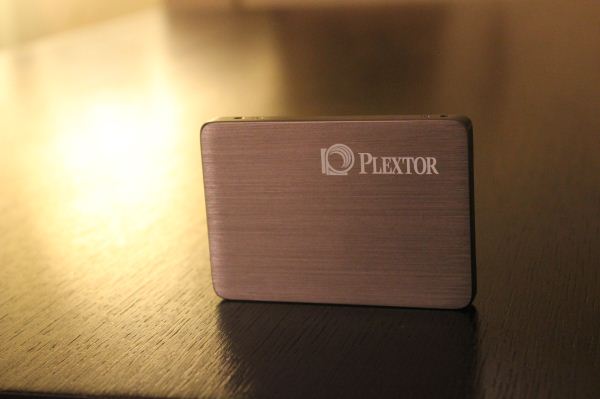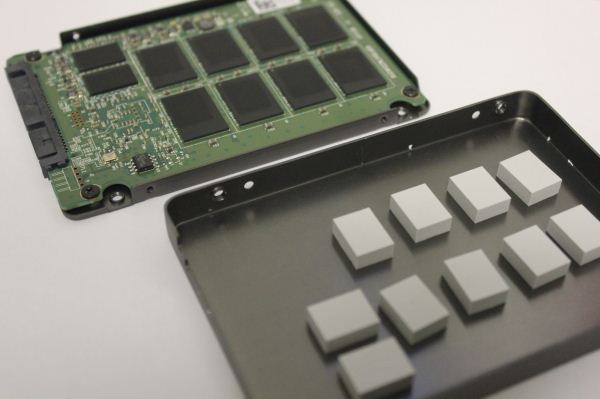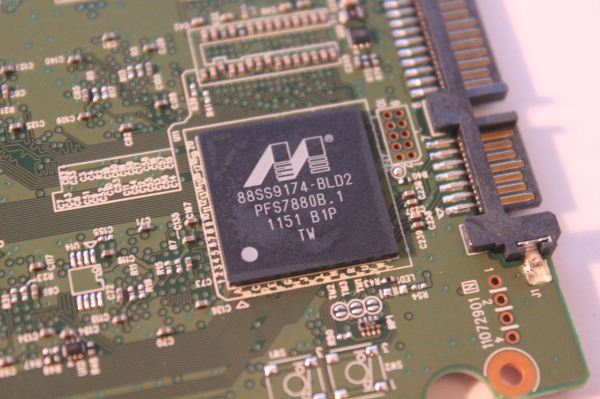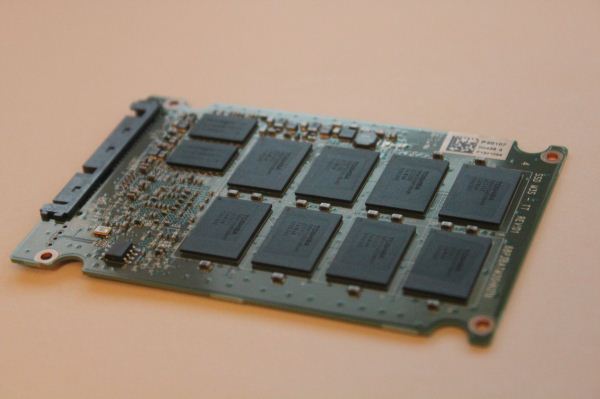The Plextor M3 (256GB) Review
by Kristian Vättö on April 5, 2012 3:05 AM ESTThe Plextor M3
Plextor sent us a 256GB model of their M3 series. Below is a table containing the specifications of their M3 line.
| Plextor M3 Specifications | ||||
| Model | PX-64M3 | PX-128M3 | PX-256M3 | PX-512M3 |
| Raw NAND Capacity | 64GiB | 128GiB | 256GiB | 512GiB |
| Formatted Capacity | 59.6GiB | 119.2GiB | 238.5GiB | 476.9GiB |
| Number of NAND Packages | 8 | 8 | 8 | 8 |
| Number of die per Package | 1 | 2 | 4 | 8 |
| Sequential Read | 520MB/s | 510MB/s | 510MB/s | 525MB/s |
| Sequential Write | 175MB/s | 210MB/s | 360MB/s | 445MB/s |
| 4K Random Read | 55K IOPS | 70K IOPS | 70K IOPS | 56K IOPS |
| 4K Random Write | 40K IOPS | 50K IOPS | 65K IOPS | 30K IOPS |
| Cache (DDR3) | 128MB | 256MB | 512MB | 512MB |
The Plextor M3 is available in all the standard capacities. In the light of the performance specifications, the M3 looks very promising. It beats its closest match, the Crucial m4, in all aspects. It's very competitive even with SandForce based SSDs and especially the stated random read figures are great.
| NewEgg Price Comparison (4/2/2012) | ||||
| 64GB | 128GB | 256GB | 512GB | |
| Plextor M3 | $110 | $180 | $340 | $660 |
| Crucial m4 | $88 | $155 | $315 | $630 |
| Intel 520 Series | $110 | $180 | $345 | $800 |
| Samsung 830 Series | $105 | $185 | $300 | $780 |
| OCZ Vertex 3 | $90 | $178 | $340 | $770 |
Price wise the M3 is not the cheapest SSD, especially in the smaller capacities. There is about $10-15 premium in the 64GB and 128GB models but 256GB and 512GB models are more competitively priced. Crucial's m4, however, comes in as a cheaper option than the M3 at every capacity so that will be a key matchup where Plextor has to win on performance or come down in pricing.
The external design of Plextor M3 is very solid. When I first saw it, it reminded me of Samsung 830 with its brushed metal finish. Only the Plextor logo has been printed on the front—The model and other important information are printed on a sticker on the back of the drive. The drive package includes a 3.5" bracket, quick installation guide, and a software CD, which includes a clone&backup utility along with performance analyzer. Plextor is giving the M3 a top notch 5-year warranty as well.
Each of the main components (controller, NAND devices, and DRAM) have their own little thermal pad. Since the chassis is also made out of metal, heat dissipation should not be a problem.
Inside we find Marvell’s 88SS9174-BLD2 controller (or just 9174). This is the same controller that's in Crucial's m4, but the firmware is custom developed by Plextor. It’s actually a bit surprising, yet very refreshing, to see a Marvell based SSD for a change. Everyone seems to have a SandForce solution these days. We have seen that Marvell can be competitive; you just need to take the time to customize the firmware to get good performance. The stock SandForce firmware is fast enough, so it's obvious that many companies choose to go with the easiest option.
Flip the PCB and we find eight Toshiba 24nm 2-bit-per-cell MLC NAND devices. That’s coupled with two 256MB DDR-1333 chips from Nanya, giving a total of 512MB of DDR3 cache.
Toshiba uses a Toggle-Mode interface and the current iteration (2.0) of Toggle-Mode NAND is good for up to 400MT/s per interface. Rating speed by transfers is a bit annoying as it doesn't tell us the actual bandwidth—for that we need the width of the channel and transfers per second. The channel in this case is 8 bits wide, so that works out to be 3.2Gbps per interface, or 400MB/s. With eight NAND packages, the maximum throughput works out to be 3200MB/s, over four times more than what SATA 6Gb/s can provide. Of course, reading from NAND and dumping the data into a register is one thing; it's another matter to actually transfer the data to a host controller over the interface.
We want to provide a quick word about firmware updates before we go into benchmarks. The drive came with FW 1.01, which was the latest at that time. Plextor has recently released FW 1.02 which is supposed to fix some issues but all our tests have been done using FW 1.01. Plextor is not claiming increased performance in the release notes of the update. The actual process of updating the firmware is very simple. Download a small ISO (~3MB) from Plextor's site, burn that to a CD or USB stick and boot from that. Press Enter and it automatically flashes the drive. I even had all my other drives plugged in and there was no problem.
The Test
| CPU |
Intel Core i5-2500K running at 3.3GHz (Turbo and EIST enabled) |
| Motherboard |
AsRock Z68 Pro3 |
| Chipset |
Intel Z68 |
| Chipset Drivers |
Intel 9.1.1.1015 + Intel RST 10.2 |
| Memory | G.Skill RipjawsX DDR3-1600 2 x 4GB (9-9-9-24) |
| Video Card |
XFX AMD Radeon HD 6850 XXX (800MHz core clock; 4.2GHz GDDR5 effective) |
| Video Drivers | AMD Catalyst 10.1 |
| Desktop Resolution | 1920 x 1080 |
| OS | Windows 7 x64 |
Our regular readers may notice that my testbed is not exactly the same as Anand's. Anand's setup is based on Intel's motherboard with H67 chipset, whereas mine is an ASRock board based on Intel's Z68 chipset. The important bit here is that both feature native SATA 6Gb/s support and both setups use the same drivers. Other features and components don't really have an effect on SSD testing. For example the average CPU usage during write speed tests is less than 5%.














113 Comments
View All Comments
Tor-ErikL - Thursday, April 5, 2012 - link
In europe plextor is one of the pioneers in the IT industry. They where one of the first to enter the cd-burner market way back in the days. They are generally known in europe to produce some of the finest quality products when in comes to cd-burners and back in the days it was the only burner to own ;)Tor-ErikL - Thursday, April 5, 2012 - link
I'm not surprised that they come up with another good quality product here, they have always been more expensive than others but you always get a good quality product from them.Fujikoma - Thursday, April 5, 2012 - link
The last Plextor optical drive I had broke within months. It was very flimsy and the shipping to have it fixed was more than buying a replacment from another vendor that had the same build quality. Plextor's quality isn't any different than other cheap drive manufacturers even though their price is.Maiyr - Thursday, April 5, 2012 - link
I am still using a PleXCombo 20/10/40-12A. My experience in no way mirrors yours. I got this thing and another drive in 2002/2003 and both are still going strong. No problems.Maiyr
hansmuff - Thursday, April 5, 2012 - link
Those were different times.I have two plextor drives:
SCSI UltraPlex 40MAX, the best CD reader ever built.
ATAPI 8/4/32 CD burner. Also a really excellent drive.
Those were "expensive" back then. The ultraplex was $140, the 8/4/32 was ~$90.
After those, drive prices tumbled and Plextor used cheapo OEM drives like everyone else and rebadged them.
Both you and Fukikoma are correct.
vol7ron - Thursday, April 5, 2012 - link
Was going to say something similar.It's like how Seagate has had good drives, but they do have bad batches, especially as they're refining their process.
Quality should not be solely determined on the product. How a company responds to a defective, or poorly made product should extend into the definition of quality. It might not be product quality, but quality of the experience is more important.
Like, I might get a bad part off Newegg, but they have great customer service that make it easy to ship it back and receive a replacement or a refund. I know they're only a middle man in the process, but the tradeoff is having a good product with good customer service, that reduces customer hassle.
Sabresiberian - Saturday, April 7, 2012 - link
The thing that makes me wonder what's going on with your post is the way you describe Plextor's quality as not being better than "any other cheap drive". The fact is, there are near a dozen DVD burner brands that cost less than $25 that are reliable pieces of hardware. They are inexpensive, but they aren't cheap.I'm another person with a Plextor drive that's been around for a couple of builds, and will soon go in a third. Do I think it will outlast my LG drive I bought a couple of years later? No, but Plextor help set reliability and top-notch performance standards that are the reasons we have inexpensive and reliable burners now.
;)
andylawcc - Thursday, April 5, 2012 - link
ditto: Plextor made one of the best CD-Burner back then (talking only about, just late 1990).note to Mr. Vatto: you could have skipped that the line, we wouldn't know. ;p
JarredWalton - Thursday, April 5, 2012 - link
Note to our readers: Kristian is 17. When optical drives mattered (in terms of benchmarks), he would have been about 10.Kristian Vättö - Thursday, April 5, 2012 - link
I'm 18 now and have been for a few months ;-)